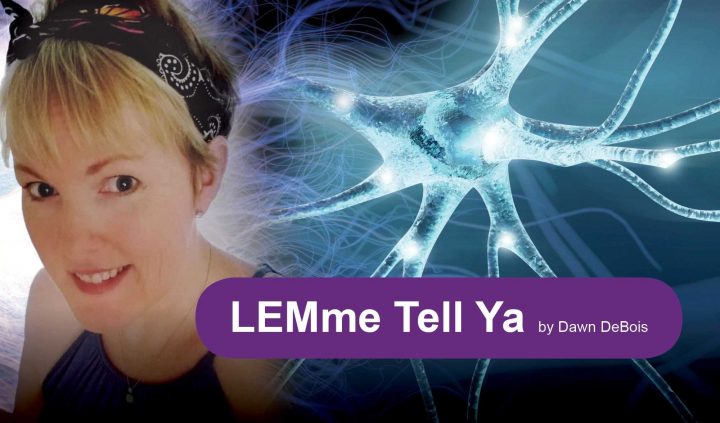How Do You Tell Someone You Have a Disease They’ve Never Heard Of?
Written by |

If you are like me, when you finally received a diagnosis of Lambert-Eaton myasthenic syndrome (LEMS), you were excited to tell the world what has been causing your unexplained exhaustion, numbness, weakness, difficulty swallowing, and difficulty walking. I was ready to shout it from the rooftops! Because we have an ultra-rare disease, however, most people have never heard of it, and when we tell someone, we often get a puzzled look in response.
Every LEMS patient knows how the conversation goes:
“The doctors finally figured out what I have! I have Lambert-Eaton mysasthenic syndrome, or LEMS! I’m so relieved to finally know what it is.”
“You have what?”
People know what cancer, arthritis, conjunctivitis, pneumonia, hypertension, arthritis, IBS, and numerous other common conditions are. However, if you have one of the 7,000 known rare diseases — LEMS is actually ultra-rare, meaning fewer than 200,000 people are affected by it in the entire United States — your support system has most likely never heard of it and, therefore, has no idea how to support you.
“I have LEMS! It’s super rare! It was discovered by two doctors from the Mayo Clinic, Dr. Lambert and Dr. Eaton.”
“Who are they?”
“They are two doctors who figured out the cause of my neuromuscular dysfunction.”
“A dysfunction junction? What?”
Soon, you realize your explanation needs to be tweaked so that your friends and loved ones will understand. The following are some of the descriptions I have used over the years with both laypeople and medical professionals. Hopefully, they will help you to describe LEMS to your friends, family, and providers who have never heard of it before.
“You’ve heard of acetylcholine? It’s the messenger needed to bring my muscles the message to move. I have antibodies that stop the message from leaving my nerves, so my muscles don’t get the message. What I have is so rare, it’s estimated only about 2.5 people per million have it! It’s called LEMS.”
Sometimes I don’t want to even bring up acetylcholine or the name of the disease, so I go even more basic:
“I have an autoimmune disease that attacks my nerves. It stops my nerves from releasing the messenger needed to tell muscles to move. I’m fortunate, though, because there are treatments available that allow the message to get through better. Not everyone with a neuromuscular disease is so fortunate.”
Everyone with LEMS knows the response from a doctor who has never encountered it: “Uh, I read a paragraph about it in medical school.” The reality is, most doctors will never see a LEMS patient because we are so rare. I have learned that, when talking with a new medical provider, instead of asking them about something they don’t know, I should ask them about something they do know:
“Have you heard of myasthenia gravis?” They always say yes. “Great! I have something very similar to MG. Instead of the muscles not being able to receive the messenger, LEMS has antibodies that stop the messenger from being released from the nerve terminal.” This explanation of LEMS has always initiated a great discussion with any provider, whether it be in an office or emergency room setting.
Your explanation may leave your friends and family members with many questions. Once your treatment plan has started, though, they will be able to see for themselves what LEMS is all about.
I recently spoke with a dear friend whom I worked with just prior to the time my symptoms escalated in severity. Our paths continued to cross at interesting moments during my LEMS symptom progression and treatment. She was the first person to exclaim, “Look at you! You’re walking with your head up!” after my treatment started. She is now one of my biggest cheerleaders. She even generously donated her time and talent to create my banner image for this column. In our most recent conversation, she commented on how amazed she is at the success of my treatments.
If your explanation of LEMS does not resonate with your loved ones initially, as your treatment plan gets figured out and “you” begin to return, your loved ones will absolutely understand what LEMS is about. Many people have said to me, “Dawn, you are like you were years ago.” For that, I am incredibly grateful.
***
Note: Lambert-Eaton News is strictly a news and information website about the disease. It does not provide medical advice, diagnosis, or treatment. This content is not intended to be a substitute for professional medical advice, diagnosis, or treatment. Always seek the advice of your physician or other qualified health provider with any questions you may have regarding a medical condition. Never disregard professional medical advice or delay in seeking it because of something you have read on this website. The opinions expressed in this column are not those of Lambert-Eaton News or its parent company, Bionews Services, and are intended to spark discussion about issues pertaining to Lambert-Eaton myasthenia.





Leave a comment
Fill in the required fields to post. Your email address will not be published.